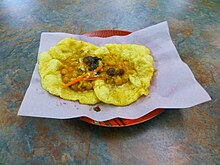Doubles (food)
 Doubles | |
| Place of origin | Trinidad and Tobago |
|---|---|
| Region or state | Caribbean, United States, Canada, United Kingdom |
| Created by | Doubles is a slight variation of chole bhatura or channa bhatura which originated in India and was brought to Trinidad and Tobago by East Indian indentured labourers between the years 1845 to 1917. |
| Serving temperature | Hot |
| Main ingredients | Curry chickpea and bara |
| Other information | Served with: various chutneys, kuchela, and pepper sauce |
Doubles is a common street food originating from India as chole bhatura or channa bhatura. It was then brought to Trinidad and Tobago by East Indian indentured labourers during the years 1845 to 1917 and was slightly modified. There is no inventor of Doubles in Trinidad and Tobago because each family or community made variations of the original dish from India. It consists of curried chickpeas served on two fried flatbreads. It is normally eaten during breakfast, but is also eaten occasionally during lunch or as a late night snack and popular hangover food.
Origins
Doubles was inspired by a north Indian dish called chole bhatura (or sometimes channa bhatura). This dish was brought to Trinidad and Tobago by East Indian indentured labourers during the years 1845 to 1917. Each family or community would have made their own variation based on ingredients available and their taste preference. Eventually persons began to sell one bara and channa until customers started asking for two baras, hence the name Doubles came about. [1] Chole bhatura is made by combining channa masala and bhatura (poori), which is a fried bread made with maida flour, a common flour in Indian baking.
Preparation
As a base for the curry, onions, garlic and curry powder are fried briefly.[2] Boiled and drained chickpeas are added together with some water and spices, primarily cumin. The curry is cooked until the chickpeas are tender. A dough is prepared, shaped into flattened circles and briefly deep fried. Doubles can be served spicy, sweet, or savory. Condiments include spicy pepper sauce, kuchela, or green mango, culantro), cucumber, coconut, and tamarind chutneys.[3]
Cultural significance
Given the diversity of Trinidad, doubles is credited with its ability to "define and maintain symbolic boundaries of identification", and is considered an authentic standard of Trinidadian cuisine.[3] Doubles is a comfort food for displaced Trinidadians in major cities across the globe.[3] Its consumption has been credited with developing a "deep psychological imprinting" among them, and as such is considered culturally significant for how it encapsulated Trinidadian identity into a simple and unique snack.[3]
See also
References
- ^ Ganeshram, Ramin (28 February 2022). "Trinidad's addictive spicy street snack". BBC Travel. Retrieved 24 November 2023.
- ^ The Multi-Cultural Cuisine of Trinidad & Tobago. Naparima Girls' High School Cookbook. San Fernando: Naparima Girls' High School. 2002. p. 85. ISBN 976-8173-65-3.
- ^ a b c d Plaza, Dwaine (9 July 2014). "Roti and Doubles as Comfort Foods for the Trinidadian Diaspora in Canada, the United States, and Britain". Social Research: An International Quarterly. 81 (2): 463–488. doi:10.1353/sor.2014.0021. ISSN 1944-768X. S2CID 142287294.
